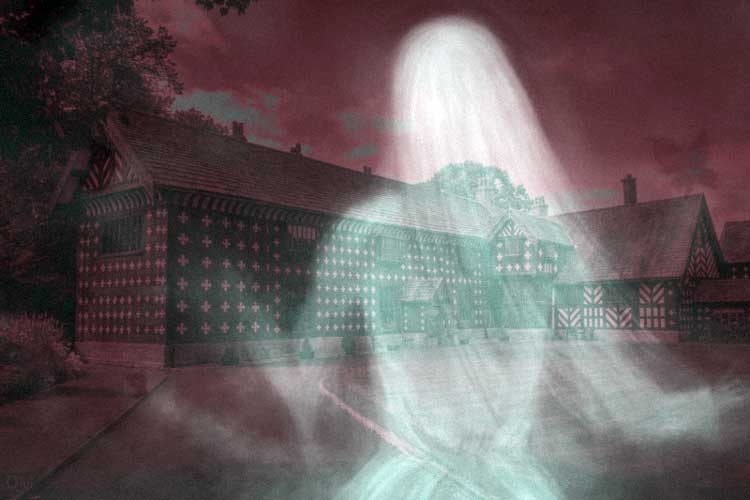Two star-crossed lovers led to the haunting of Salmesbury Hall in Lancashire, says BARRY McCANN
The Lancashire village of Salmesbury stands on the A59 between Preston and Blackburn, and boasts a magnificent Tudor Hall standing in its own grounds.
It was built in 1325 by Gilbert de Southworth and remained home of the Southworth family until the early 17th century.
Now used for wedding receptions and housing an antiques emporium, the hall is open to the public, though there is one visitor usually seen at night. A woman in white who wanders alone.
The haunting of Salmesbury Hall
This tragic figure is thought to be the 16th century Lady Dorothy (Dorothea) Southworth. Her zealously catholic and defiantly remained so despite the reformation and the hardship this brought to “Papists.”
Lady Dorothy fell in love with a young man from the de Hoghton family who were strongly Protestant and neither house approved of the union with the other.
With permission to marry refused, the pair continued to meet in secret along the River Ribble’s banks or in the nearby woods, and conceived a plan to elope and marry. Unfortunately, intelligence of their intention was relayed to Samlesbury Hall.

On the night of elopement, Dorothy’s brother, Christopher, and other conspirators waited in ambush at the planned rendezvous. When de Hoghton arrived, they killed him, along with his two accompanying retainers. The bodies were buried under the cover of darkness within the grounds of the Hall’s chapel.
Dorothy was said to have witnessed her lover’s violent death and remained inconsolable. She was sent to a convent abroad and remained there for the rest of her life, descending into grief-fuelled madness. It is said her dying words were a whisper of her murdered lover’s name.
Human remains uncovered during digging
Later in 1826, the remains of de Houghton and his two companions were unearthed during the digging of a road near the Hall, which at least verified their fate and brought some closure to their story.
However, it seems this is not enough for Dorothy’s troubled spirit. She has been seen many times in the corridors and grounds of Salmesbury Hall, apparently moaning and searching for her missing lover. But her search is not just confined to the Hall itself.
Over the years, bus drivers have reported pulling up to the stop just in front of the Hall on the main road to pick up a waiting passenger.
Ghost sightings at Salmesbury Hall
However, when the doors open there is no one there.
On each occasion this mysterious figure has been described as a woman who, dressed in period costume, the drivers have assumed to be a member of the hall’s staff waiting to go home at the end of her shift.
Given her lover’s body had been hidden in the very ground the road now runs over perhaps she senses the trail of his final hours ends there and waits in vain for him to return.
So should anyone witness the White Lady don’t be afraid. Just be sympathetic.








I’ve seen Dorothy. I can help her. Her and her lover the young hoghton boy. Poor girl.
But, the de Hoghton were stanch Catholics, even Queen Elizabeth wrote a letter, angry that the heir escaped to the continent to avoid being arrested. And people keep saying Dorothy lived in the 13th century. But there was no Protestant faith in th 13th century, and Dorothy lived in the 16th century. So who is the ghost?? Not the “oldest” haunting (13th c) and Not b/c of religious grounds since BOTH families were stanchly Catholic.
Kate- I am a little confused by some of your comments as they run contrary to what the article actually says. Firstly, the article states unequivocally that Lady Dorothy lived in the 16th century and not the 13th as you appear to suggest it does. It makes no claim of the white lady being the oldest haunting and does not even conclude that it is the ghost of Lady Dorothy, only “thought” to be her.
The story behind the haunting is the received wisdom recorded and reported in the various documentation I examined while researching the piece, which state her lover to be a de Houghton whose (immediate at least) family were protestant. However, the writings are not specific about exactly which branch of the family he came from. The family of Hoghton Tower around this time were catholic, but assuming the story to be true it seems the de Houghton of this record was apparently not of that particular family branch.
If you are aware of evidence that Dorothea’s lover was definitely catholic and therefore another motivation to his murder, please can you cite your source so I may verify for myself and, if satisfied, possibly update the piece.
Hi Barry, I grew up in between Samlesbury Hall and Hoghton Tower, I lived on Bell Villa’s, j I 9ust off Gib Lane, I am convinced I saw Dorothy (the white lady) walking past my house on more than one occasion, I used to think she was trying to get to Hoghton Tower, do you think this is possible? I know the lady I saw was a spirit.
Hi Samantha – It could possibly be her but just as impossible to say. The white lady figure is usually seen on the A677 in front of the hall and there have been reports of bus drivers stopping to pick her up thinking she is staff in period costume. The figure is attributed to be Dorothea but no one knows for sure. If a white lady did walk past where you lived the there is another figure that needs investigating, though the proximity of Bell Villa is quite close to where Dorothea lived.
Hi I would like to know if there was a ring found with the body’s that where recovered.
That is an interesting question. I have not come across any reports as such, but will keep my eyes open on that subject.